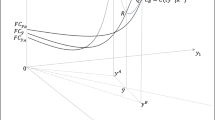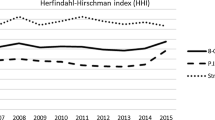Abstract
A new dynamic Data Envelopment Analysis (DEA) approach is created to provide valuable managerial insights when assessing the merger performance. This new approach allows us to dynamically evaluate the pre-merger firms and the post-merger firm in a multi-period situation. A case study of bank branch merger is conducted to illustrate and validate the proposed approach. Both stochastic frontier analysis and data envelopment analysis are used and compared leading to highly correlated results. The computation show that merger results in an overall efficiency achievement in a banking industry.
Similar content being viewed by others
References
Akhavein, J. D., Berger, A. N., & Humphrey, D. B. (1997). The effects of megamergers on efficiency and prices: evidence from a bank profit function. Review of Industrial Organization, 12, 95–139.
Amirteimoori, A. (2006). Data envelopment analysis in dynamic framework. Applied Mathematics and Computation, 181, 21–28.
Banker, R. D., Charnes, A., & Cooper, W. W. (1984). Some models for estimating technical and scale inefficiencies in data envelopment analysis. Management Science, 30, 1078–1092.
Battese, G. E., & Coelli, T. J. (1995). A model for technical inefficiency effects in a stochastic frontier production function for panel data. Empirical Economics, 20, 325–332.
Berger, A. N., & Humphrey, D. B. (1992). Megamergers in banking and the use of cost efficiency as an antitrust defense. Antitrust Bulletin, 37(3), 541–600.
Berger, A. N., & Humphrey, D. B. (1997). Efficiency of financial institutions: international survey and directions for future research. European Journal of Operational Research, 98, 175–212.
Berger, A. N., Clarke, G. R. G., Cull, R., Klapper, L., & Udell, G. F. (2005). Corporate governance and bank performance: a joint analysis of the static, selection, and dynamic effects of domestic, foreign, and state ownership. Journal of Banking and Finance.
Bogetoft, P., & Wang, D. (2005). Estimating the potential gains from mergers. Journal of Productivity Analysis, 23, 145–171.
Charnes, A., Cooper, W. W., & Rhodes, E. (1978). Measuring the efficiency of decision making units. European Journal of Operational Research, 6(2), 429–444.
Clark, J. A. (1996). Economic cost scale efficiency, and competitive viability in banking. Journal of Money, Credit, and Banking, 28(3), 342–364.
Coelli, T. J. (1992). A computer program for frontier production function estimation: FRONTIER, Version 2.0. Economics Letters, 39, 29–32.
Cooper, W. W., Seiford, L. M., & Tone, K. (2000). Data envelopment analysis. Boston: Kluwer.
Cummins, J. D., & Xie, X. (2008). Mergers and acquisitions in the US property-liability insurance industry: Productivity and efficiency effects. Journal of Banking & Finance, 2(1), 30–55.
Ray, S. C. (2004). Data envelopment analysis: theory and techniques for economics and operations research (pp. 189–208). Cambridge: Cambridge Univ. Press.
Richey, R. G. Jr., Kiessling, T. S., Tokman, M., & Dalela, V. (2008). Market growth through mergers and acquisitions: the role of the relationship marketing manager in sustaining performance. Industrial Marketing Management, 37(4), 394–406.
Sherman, H. D., & Rupert, T. J. (2006). Do bank mergers have hidden or foregone value? Realized and unrealized operating synergies in one bank merger. European Journal of Operational Research, 168(1), 253–268.
Tulkens, H. (1993). On FDH efficiency analysis: some methodological issues and applications to retail banking, courts and urban transit. Journal of Productivity Analysis, 4(1/2), 183–210.
Wu, D. (2009). Performance evaluation: an integrated method using data envelopment analysis and fuzzy preference relations. European Journal of Operational Research, 194(1), 227–235.
Wu, D. & Birge, J. (2011). Serial chain merger evaluation model and application to mortgage banking. Decision sciences (accepted).
Wu, D., Yang, Z., Vela, S., & Liang, L. (2007). Simultaneous analysis of production and investment performance of Canadian life & health insurance companies using DEA. Computers & Operations Research, 2(34), 429–444.
Author information
Authors and Affiliations
Corresponding author
Rights and permissions
About this article
Cite this article
Wu, D.D., Zhou, Z. & Birge, J.R. Estimation of potential gains from mergers in multiple periods: a comparison of stochastic frontier analysis and Data Envelopment Analysis. Ann Oper Res 186, 357–381 (2011). https://doi.org/10.1007/s10479-011-0903-6
Published:
Issue Date:
DOI: https://doi.org/10.1007/s10479-011-0903-6




